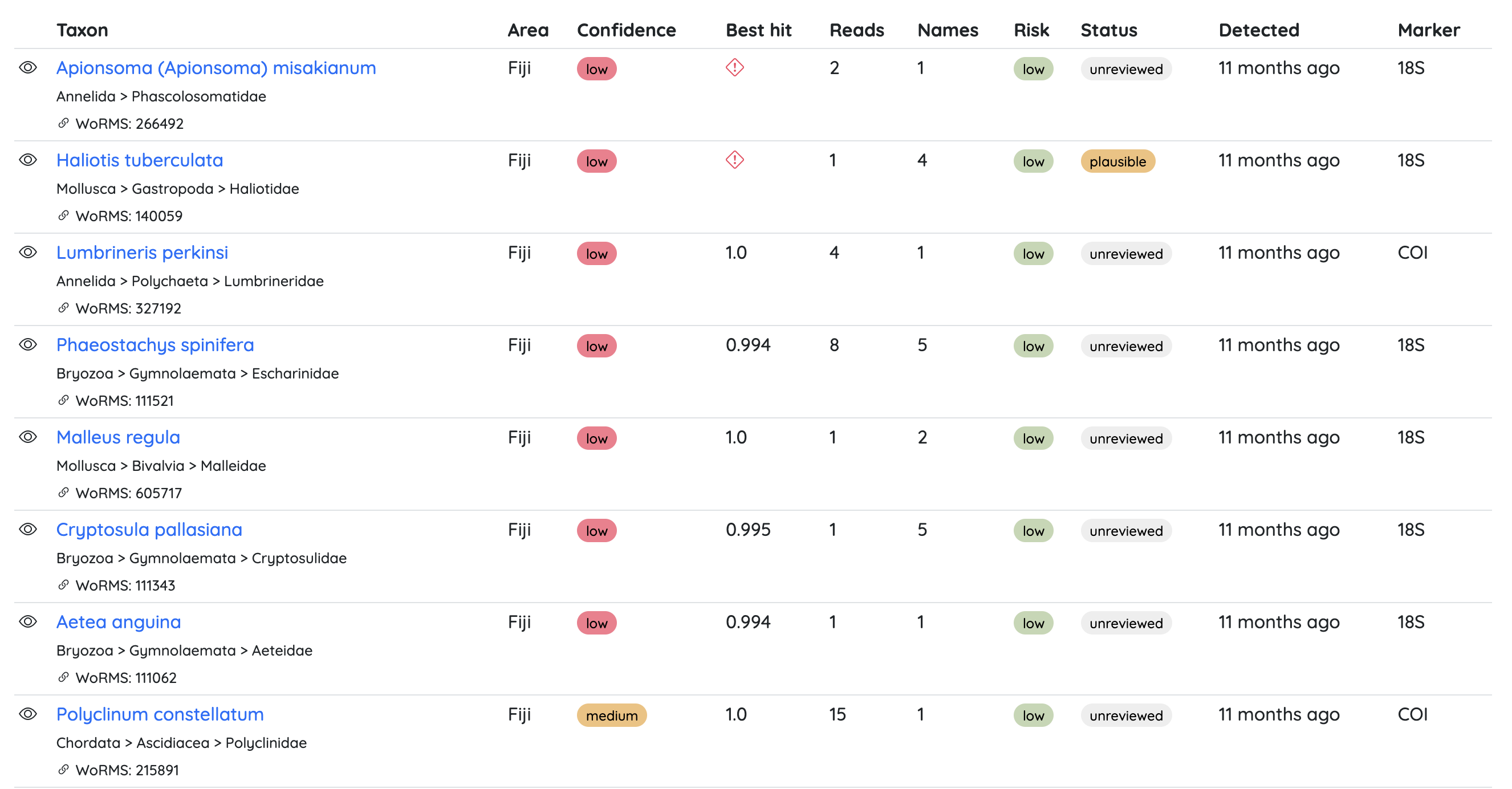News
PacMAN by OBIS - A transposable sea-to-screen framework to fight marine biorisk
14 February 2025
 eDNA sampling activities during a PacMAN training session. Photo: Ward Appeltans / OBIS
eDNA sampling activities during a PacMAN training session. Photo: Ward Appeltans / OBIS
Marine invasive species are a serious threat to biodiversity as well as the livelihoods of coastal communities and ocean-dependent industries. Bioinvasions can occur anywhere in the ocean: The 2019 IPBES global assessment estimates that the introduction of non-indigenous species to new environments—due to human activities and their consequences, such as climate change—is one of the five main drivers impacting biodiversity. With PacMAN (Pacific Islands Marine Bioinvasions Alert Network), a four-year UNESCO-IOC project in Fiji, OBIS has developed an actionable sea-to-screen framework to improve the early detection of marine invasive species and support decisions to mitigate their impact through a user-oriented dashboard. PacMAN is at the confluence of two of OBIS’s strategic goals: developing local capacity in cutting-edge biodiversity monitoring techniques and producing fit-for-purpose decision-support solutions.
Marine bioinvasions are particularly hard to detect with conventional observing techniques. The marine environment constantly changes, and marine species observations are challenging, often requiring dedicated, costly equipment. “When we started working on the PacMAN project, we rapidly settled on molecular observing techniques like eDNA and qPCR as the way to go to achieve our goals”, says Saara Suominen, OBIS scientific officer in genetic data. “eDNA was the perfect answer to our needs in PacMAN: it is cost-efficient, it works admirably well to screen vast territories at different depths for bioinvasions, and it is compatible with limited human resources.” In addition, thanks to a short sample-to-result time, eDNA is perfectly adapted to early detection requirements.
“Building with” rather than “building for”: Integrating local scientific communities to ensure long-term impact
Deploying cutting-edge molecular observing techniques in a Large Ocean State such as Fiji meant developing the local infrastructure and training local scientific teams. PacMAN contributed to organizing the first-ever training in molecular techniques in Fiji, boosted scientific engagement from local populations and raised awareness of conservation issues. “One of the project’s main outcomes was the co-design of a marine biodiversity monitoring plan with local and international scientific teams,” explains Saara Suominen. “This local involvement is the foundation for long-term engagement.” OBIS worked closely with local stakeholders to create local momentum. Together with the project manager at the University of South Pacific in Suva, Fiji, Joape Ginigini who mapped local resources, the project trained the local teams, and built expertise in molecular marine observation techniques, together with a team of marine biodiversity experts and research assistants. Engagement with key stakeholders in Fiji was crucial in gaining access to both laboratory facilities and sampling locations, and showed that there was a need for this work in Fiji.
 A view of the dashboard part of the PacMAN decision-support tool
A view of the dashboard part of the PacMAN decision-support tool
A decision-support tool geared for efficiency
To increase the framework’s robustness and preparedness, PacMAN combines local capacity building with global bioinformatics tools provided by OBIS. “We mobilized our global expertise and know-how to deploy a decision-support tool that translates the local scientific data into actionable insights,” says Pieter Provoost, OBIS Data Manager. The PacMAN project is structured around three interconnected components: DNA-derived observations; the sequencing, analysis and integration of DNA data into a bioinformatics pipeline; and the visualization of results through an integrated operational dashboard. “The bioinformatics pipeline built for PacMAN is supported by the OBIS infrastructure to ensure robustness, reliability and stability.” The PacMAN decision-support tool features an easy-to-use, straightforward interface that can allow even non-specialists, after a short training, to get instant insights on the situation of marine invasive species in Fiji at one glance. “We designed the PacMAN decision-support tool’s user interface to be as simple and efficient as possible,” asserts Pieter Provoost. “But the technology behind the tool is complex. It syncs with OBIS to retrieve up-to-date species occurrence data and performs risk assessments using the World Register of Introduced Marine Species (WRiMS) distribution data and OBIS-derived thermal niches to evaluate potential threats. Registered users can review and either accept or reject detections, add notes about species and specific areas, and modify the pest status of species in designated areas.” The result is seamless, making it click-easy for environmental managers to interpret eDNA data, identify potential invasive species and immediately take adapted action.
The World Register of Introduced Marine Species (WRiMS) is part of the World Register of Marine Species (WoRMS), hosted and coordinated by the Flanders Marine Institute (VLIZ). WoRMS provides open access to expert-validated marine taxonomic information, and within WRiMS, this taxonomic information is complemented with the latest, scientifically-based literature on the distribution of marine invasive species, their pathways of introduction into a region and their impact. “The combination of WRiMS and OBIS within the PacMAN project brings the impact and potential of both systems to a next level,” explains Leen Vandepitte, Senior scientist, project and data manager at VLIZ. “This is beneficial to all involved parties, from (citizen) scientists to policy makers and from local to global scale.”
_Athila Bertoncini Andrade_CCBY-NC-SA.jpg) The Snowflake Coral (Carijoa riisei) is part of the "Top 25 Marine non-indigenous species for the Pacific region. Photo: Athila Bertoncini Andrade / iNaturalist / CC BY-NC-SA
The Snowflake Coral (Carijoa riisei) is part of the "Top 25 Marine non-indigenous species for the Pacific region. Photo: Athila Bertoncini Andrade / iNaturalist / CC BY-NC-SA
Scalability and transposability
The successful implementation of the PacMAN framework contributed to Fiji achieving Marine Invasive Species Monitoring-Ready status, a first for a Large Ocean State, positioning the island as a leader in marine biosecurity efforts. “What we implemented in Fiji can be transposed to any other Large Ocean State and beyond,” says Ward Appeltans, OBIS Programme Manager. “We could deploy the framework in key locations around the world to sustain conservation efforts and provide marine planners and managers with a reliable, fast-response solution to monitor marine invasive species.” PacMAN is a fantastic local achievement. It’s also the blueprint for an efficient and cost-effective solution to bolster local capacity in molecular marine observation techniques to improve biosecurity, anywhere.
The 4-year PacMAN project was funded by the Flanders Government through the UNESCO-Flanders Trust Fund for Science (FUST)

